 |
|
 |
|
|
If your browser labels this site "Not Secure," don't worry. You are not typing personal
information here, so security is not needed. Click here
for more explanation.
|
|
2019
January
31
|
But there are no Leibnitz Mountains!
I said yesterday that my 1970 eclipse picture shows the Leibnitz Mountains
on the edge of the visible face of the moon:
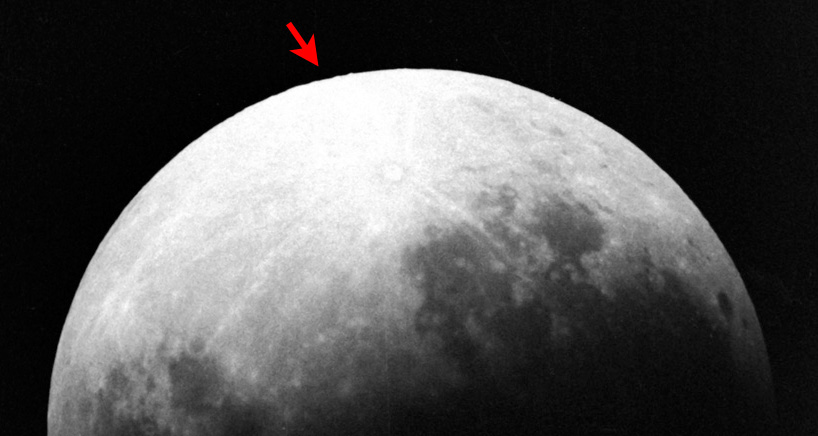
That was my understanding, since 1970. So I looked up the Leibnitz Mountains
in a modern moon atlas (the one by Rükl) and couldn't find them.
There is a crater named Leibnitz, but it's on the far side of the moon, well
out of sight. What's going on?
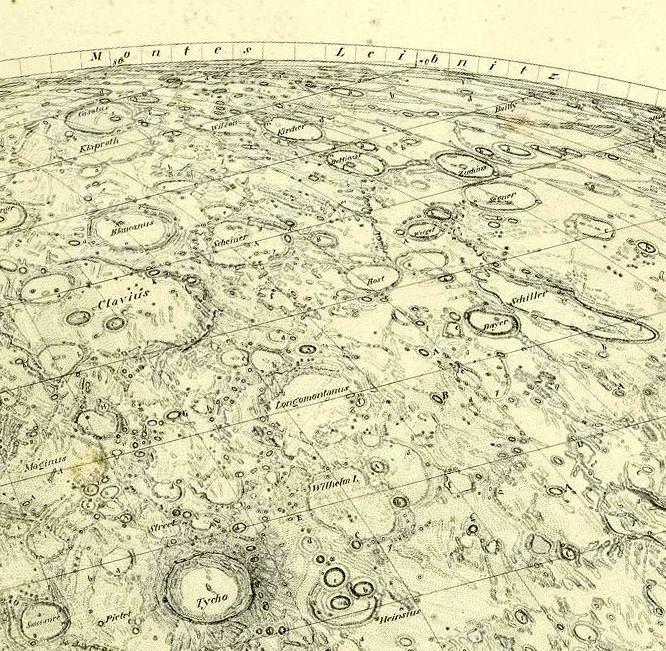
The name "Leibnitz Mountains" goes back at least to Beer and Mädler's 1834 moon map
(this copy obtained from Wikimedia Commons). So I'm not making something up.
But there is no such IAU-assigned name today.
The solution to the mystery is that something's there, but it's not a mountain range.
When the far side of the moon was explored by space probes, it turned out that astronomers
had actually been looking at a side view of several craters and smaller mountains
that are more or less elevated
because they are on the edge of a big valley.
Not a mountain range at all.
And what a valley it is! It's known as the South Pole–Aitken Basin and extends
from the south pole of the moon almost to the middle of the far side and is nearly as
wide east-west as north-south. From earth, though, we can only see a bit of its southern edge,
the illusory Leibnitz Mountains.
The peaks in my picture are near the crater Malapert, in a region that still
has not been photographed very well by space probes.
Permanent link to this entry


|
2019
January
30
|
The lunar eclipse of August 16-17, 1970
Lunar eclipses and I go way back.
My first serious astronomical observing session was for the lunar eclipse
in April, 1968. And my first presentable astronomical photograph
(published, a decade and a half later, in the first edition of Astrophotography
for the Amateur) was this one:
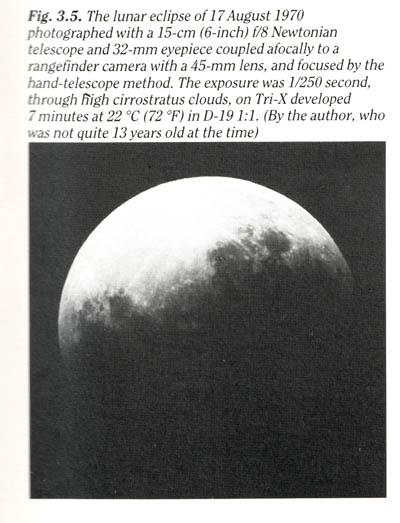
Here's a better rendering, produced (yesterday) by cleaning the negative and then scanning
it in my Nikon LS-40 and spotting out most of the remaining dust with Photoshop:
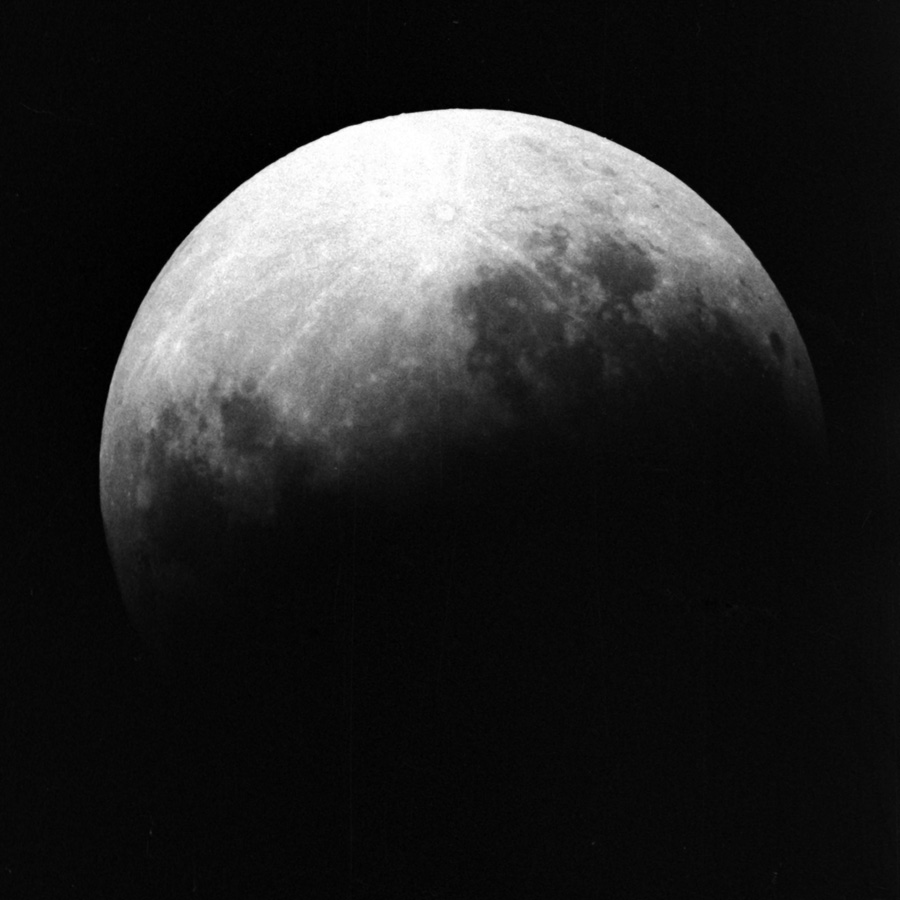
That's right — I took this before my thirteenth birthday, using an Optical Craftsmen Sirius
6-inch f/8 reflector, 32-mm eyepiece, and Petri 7 rangefinder camera.
The method of focusing is not recorded in my notes, but most likely I looked into the
telescope eyepiece with a monocular focused on the stars, then set the camera lens to infinity.
I did this at Valdosta State College Observatory, supervised by the late I. R. Jones of their
physics department.
You'll notice that the picture has excessive contrast. The film was Tri-X Pan, developed in
D-19 1:1, which is rather harsh for that kind of film; I was trying to standardize on one
developer and didn't understand the need for dynamic range in lunar eclipse photography.
Here's my notebook from those days:
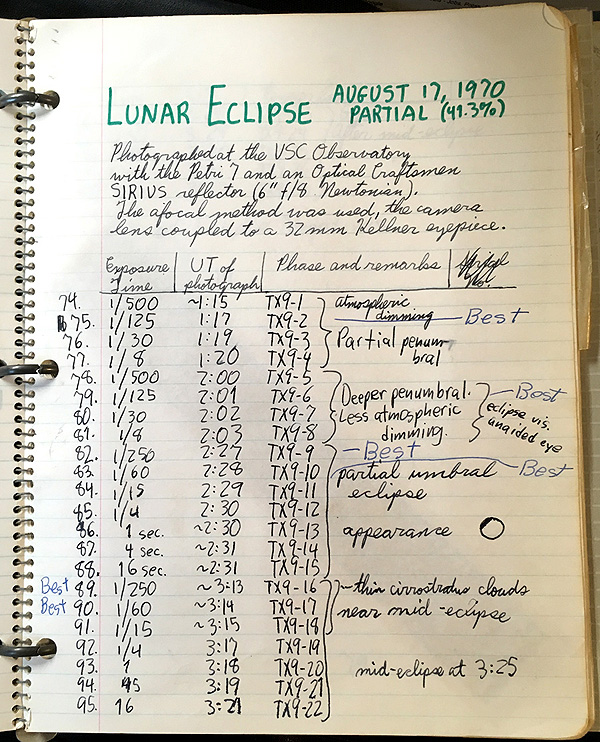
You're looking at picture number 89.
One last thing. At the time, I made an 8x10 enlargement of the picture, and my friend Richard Dasher
pointed out that the Leibnitz Mountains are visible on the bright limb of the moon.
Permanent link to this entry


|
2019
January
29
|
Now for the finished eclipse pictures
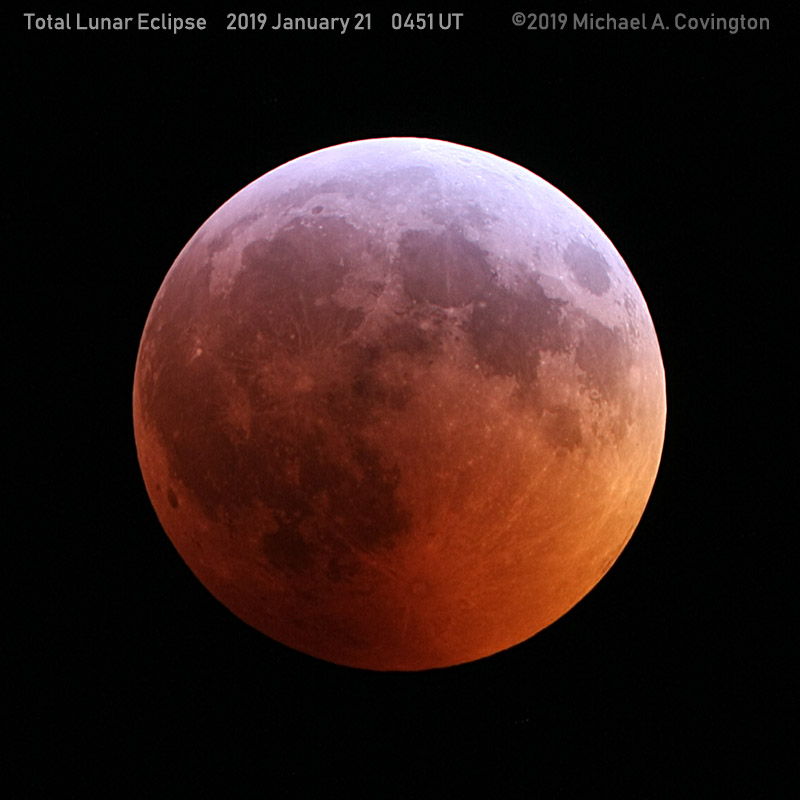
Here's my best picture of the total lunar eclipse, and there's an interesting story
behind it. As you saw in my preliminary picture a few days ago, the Canon 60Da, which
has extended red response, produced a cherry-red image that didn't look like what I saw
with my eyes. Seeing that happening, I got my trusty old Canon 40D (now old enough to be
in middle school) and tried it as an alternative. Success! These colors are much
more realistic.
This is a stack of four
1.6-second exposures at ISO 800 through an AT65EDQ 6.5-cm f/6.5 refractor, tracking at
lunar rate on my Celestron AVX mount.
Although I have raw image files, I worked from the JPEGs, stacking them with AutoStakkert 3
and postprocessing with Photoshop.
Permanent link to this entry
Partial phases
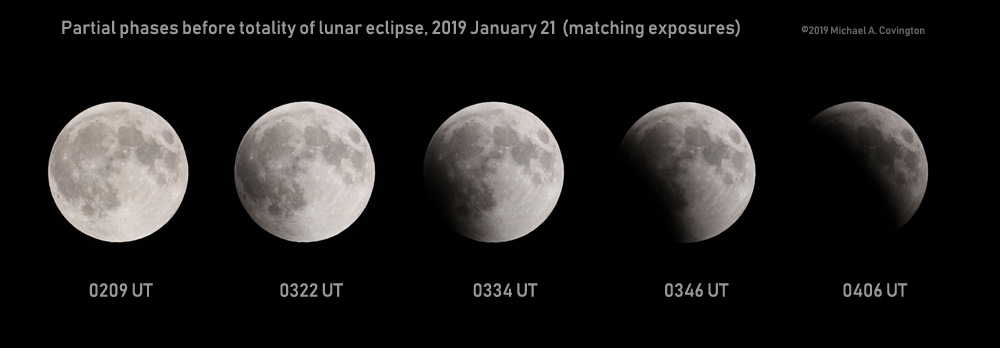
These are identical 1/1000-second exposures at ISO 200 and f/6.5, showing the uneclipsed moon,
its entry into the penumbra, and then the progression of the eclipse. AT5EDQ refractor,
Canon 60Da.
Permanent link to this entry
Moon and stars together
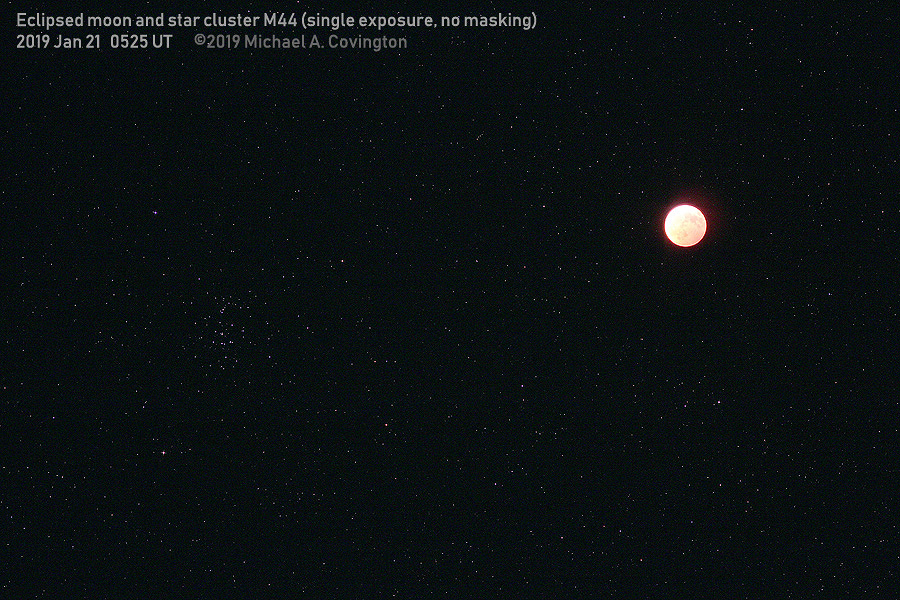
I want to emphasize something about this picture of the moon and stars together: It is a single
exposure, not a composite. I didn't cut the moon out of a short exposure and paste it into a long
exposure of the stars, which is a popular technique. (Sometimes that technique gives impossible
results, such as the dark edge of the moon appearing darker than the sky around it.) No; this is a
single 10-second exposure at ISO 800 with a Canon 60Da and a Sigma 105-mm lens at f/5.6.
I did use a sharpening filter in Photoshop to bring out the stars and also detail on the moon.
To that extent, it's not a totally unenhanced picture, but it is a single exposure.
Permanent link to this entry


|
2019
January
27
|
Lothar L. Tresp, 1927-2019
I am sad to report the passing, at age 91, of one of my most important mentors from my
undergraduate days (and, as it happens, the organizer of the event at which Melody and I met).
Dr. Lothar L. Tresp was the founding director of the University of Georgia's Honors Program,
earlier known as Programs for Superior Students.
The key idea at the time, in the 1970s, was to form a university within a university, so that
Georgia could recruit not only ordinary Georgians, but also the highly talented students who
would otherwise have gone to Harvard or Emory, and in the long run, induce such people to stay
in Georgia or in the South.
I am of course a product of that process, and so is Melody. Thanks to the Honors Program, we
had a much better undergraduate experience than a large state university could ordinarily have given us,
with access to small classes and other resources that were more like graduate school.
Paradoxically, my opinion now, after this many years, is that the Honors Program is no longer
needed — the whole university has now risen to the level that used to be the Honors Program,
and the students who wouldn't have been in the Honors Program are going to other state colleges.
But that's just me.
What I didn't know until I read the obituary is that Dr. Tresp wasn't from Germany proper.
He was born in Ortelsburg, East Prussia, which is now Szczytno, Poland, not even close to the
present German border — it is 40 miles from the little enclave of Russia that is below Lithuania.
What I did know is that he was drafted at a young age and briefly fought for Germany in WWII.
Much later, there was a dispute about whether membership in Phi Beta Kappa could be conferred on
someone who had waged war on the United States. When I was asked, I replied by asking what they
had done about people who fought for the Confederacy. I never found out if he got the membership.
Permanent link to this entry
More short notes
I must also note the passing of Larry Rowell, a
second-grade classmate with
whom I had recently reconnected on Facebook.
He lived in Kentucky and was a bivocational (trivocational?) pastor, newspaperman,
and businessman.
I had a good trip to Imaging USA, the photography trade show, in Atlanta on January 21.
Still convalescing from the flu, I wasn't too energetic and spent only an hour and a half there,
but I had good conversations with people from Canon, Kodak, Zeiss, and Sigma.
Oddly, the Kodak representative had heard of me — Astrophotography for the Amateur is
apparently part of the technical literature of film photography. They gave me two rolls of Ektachrome,
which I'm going to test against DSLRs for astrophotography.
We have had a major shift in political climate — for which Wagner fans have already
come up with a name, Trumperdämmerung — and I stand by my position that shutting
down the government is as wrong as hostage-taking. Fortunately it has reopened, temporarily.
And I have had fame thrust upon me. This posting, in the "Overheard at UGA" group on
Facebook, garnered over 500 "likes" and no strong dissent. It was reassuring to find that although
we have vapers on campus, they are massively unpopular. It must have been good for them to find
this out, too.
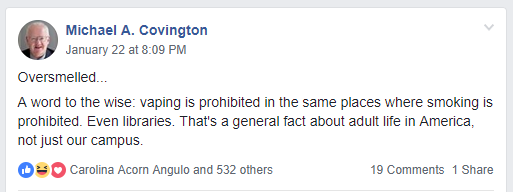
Permanent link to this entry


|
2019
January
23
|
Yes, we had a very fine eclipse
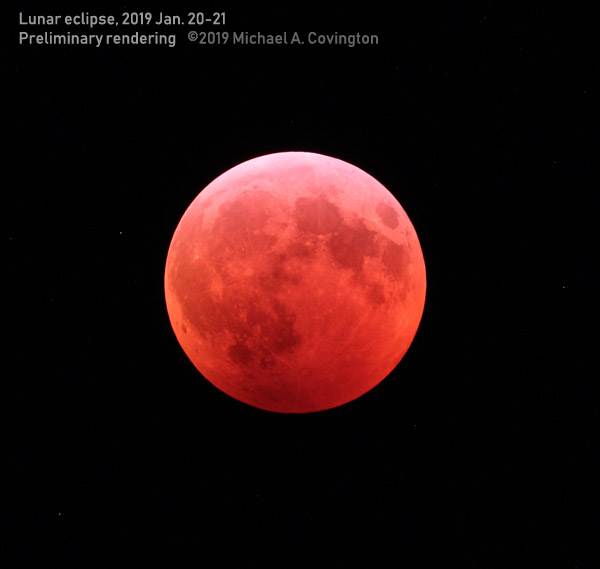
We had a very fine view of the lunar eclipse on the night of January 20-21.
Here in Athens, Georgia, the sky was clear, but the temperature was 30 F with a
constant 7-mph wind, giving a wind chill of 23 F, the coldest weather in which I
think I've ever had a prolonged observing session.
All the equipment worked well. I photographed the eclipse with my AT65EDQ
6.5-cm f/6.5 apochromatic refractor and also viewed it with my vintage Celestron 5.
I'll have more and better pictures later, but above you see a preliminary rendering
of one of them. 2-second exposure, Canon 60Da, ISO 800, f/6.5.
Permanent link to this entry
Moon among stars
An eclipse is the only time you can photograph (or even see) the full moon with stars
around it. Strange but true — look at the real sky, rather than drawings and
paintings, if you don't believe me.
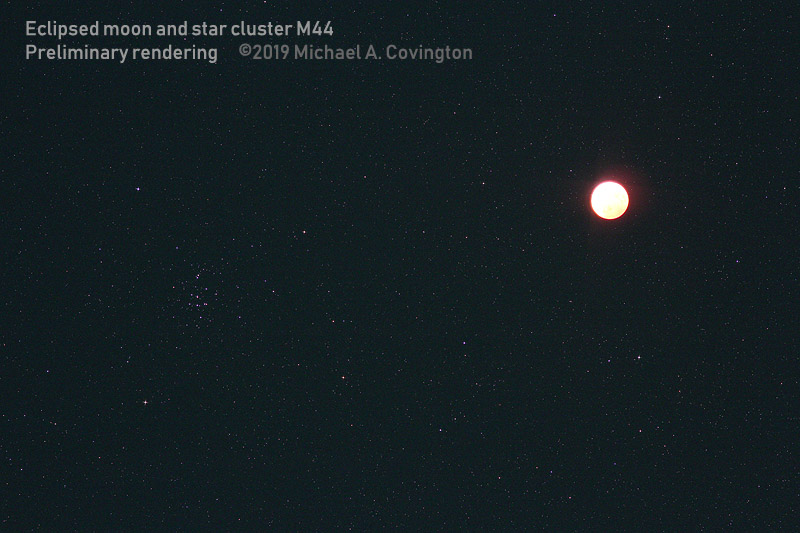
Here you see the moon and, at the left, the star cluster M44. This was taken with a 105-mm
f/2.8 Sigma lens at f/5.6; it's a 30-second exposure with the Canon 60Da on a mount tracking
the stars at sidereal rate.
Permanent link to this entry
Other notes
As I've mentioned, the day I got Melody home from the hospital (Jan. 5) I came down with
the flu and was mostly out of work for two weeks, and run down for a while after that.
Normal activity resumed on January 21 and I went to Imaging USA, the same photography
trade show as three years ago. Canon was there in force; Nikon did not have an exhibit
at all; Zeiss and Sigma showed me some nice lenses; and Kodak gave me two rolls of Ektachrome.
The Kodak representative had actually heard of me —
apparently Astrophotography for the Amateur is now part of the technical
literature of film photography.
Also, the University of Georgia recently released a picture of construction in progress
in the area that used to be my office. The basement of Boyd Graduate Studies was the
computer center in my undergraduate days; I spent a lot of time there.
While I was away from 1977 to 1984, they filled in a lot of open spaces and corridors
to build more offices, so the whole area became a U shape rather than a grid of hallways.
In the late 1980s the AI group moved here, so my office was in what had been the
director's suite, and our electronics lab was in what had been an open lobby.
Now they've gutted it. Apparently it's going to be rebuilt almost beyond recognition.
At least I can use the elevators as a fixed reference point, when they reopen the
basement and I explore whatever they've built in my old haunts.
Permanent link to this entry


|
2019
January
16
|
Practicing for the eclipse
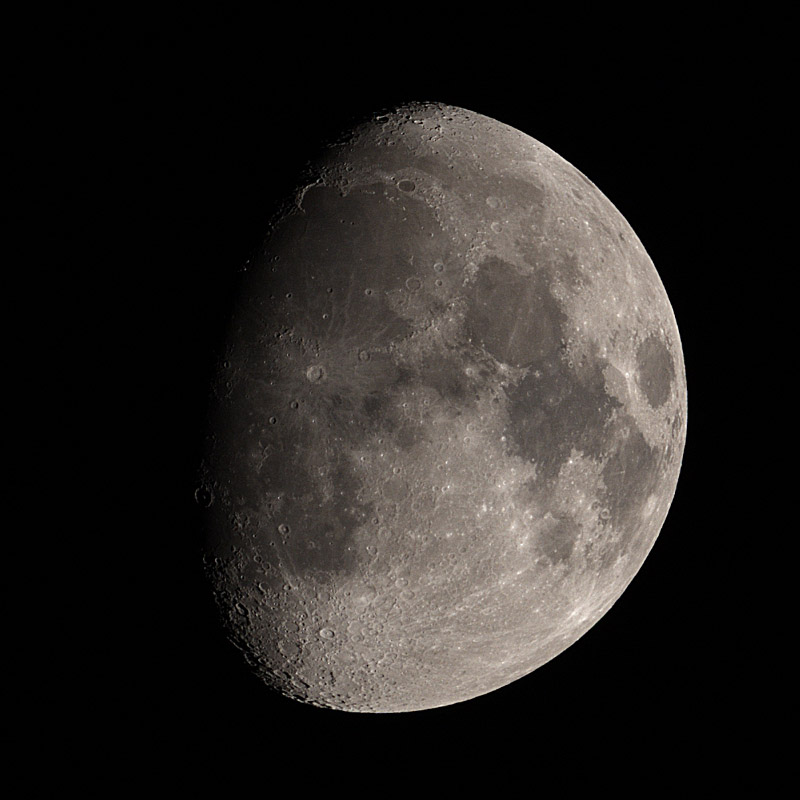
We have a total lunar eclipse coming up on the 20th, and I plan to photograph
it with my AT65EDQ refractor.
To practice, I took this picture of the moon this evening (January 16).
Single 1/400-second exposure, Canon 60Da using Live View Silent Shooting
(what everyone else calls electronic first-curtain shutter), ISO 200,
postprocessing with PixInsight and Photoshop.
Permanent link to this entry


|
2019
January
10
|
Nebulae in Auriga
On the evening of January 5, while I was coming down with the flu and
didn't know it, I did a bit of astrophotography using the AT65EDQ 6.5-cm f/6.5
refractor, Canon 60Da body, and AVX mount (with PEC but without autoguiding).
This is my quick-and-easy setup.
Here you see, at the upper right, the Flaming Star Nebula (IC 405) with the star
AE Aurigae in the middle of it. That star was formed a long way away and is now
just moving through this gas cloud. To the lower left is the star cluster NGC 1893,
which is associated with the nebula IC 410.
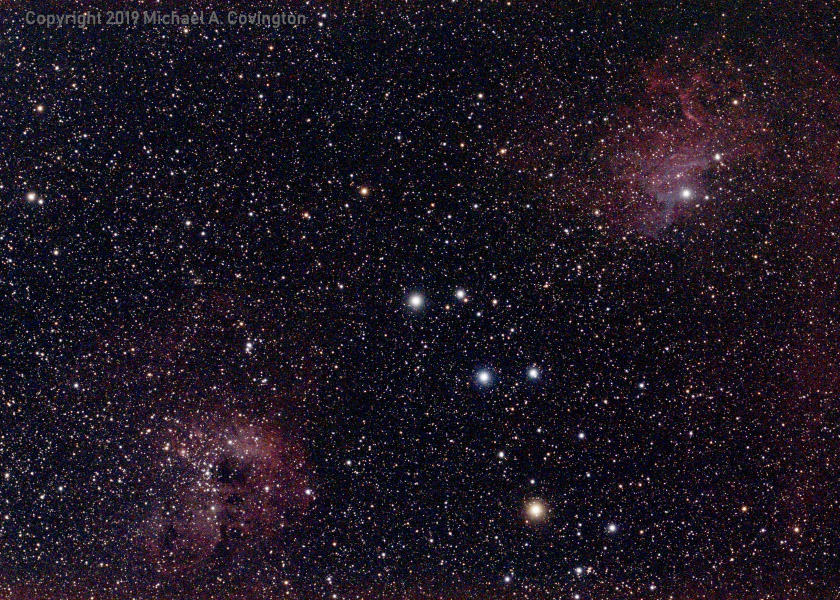
Stack of 17 1-minute exposures.
Nearby, almost in the same field, are several other interesting objects.
Here, from right to left, are the nebula IC 417, the small nebula NGC 1931,
and the well-known star cluster M36.
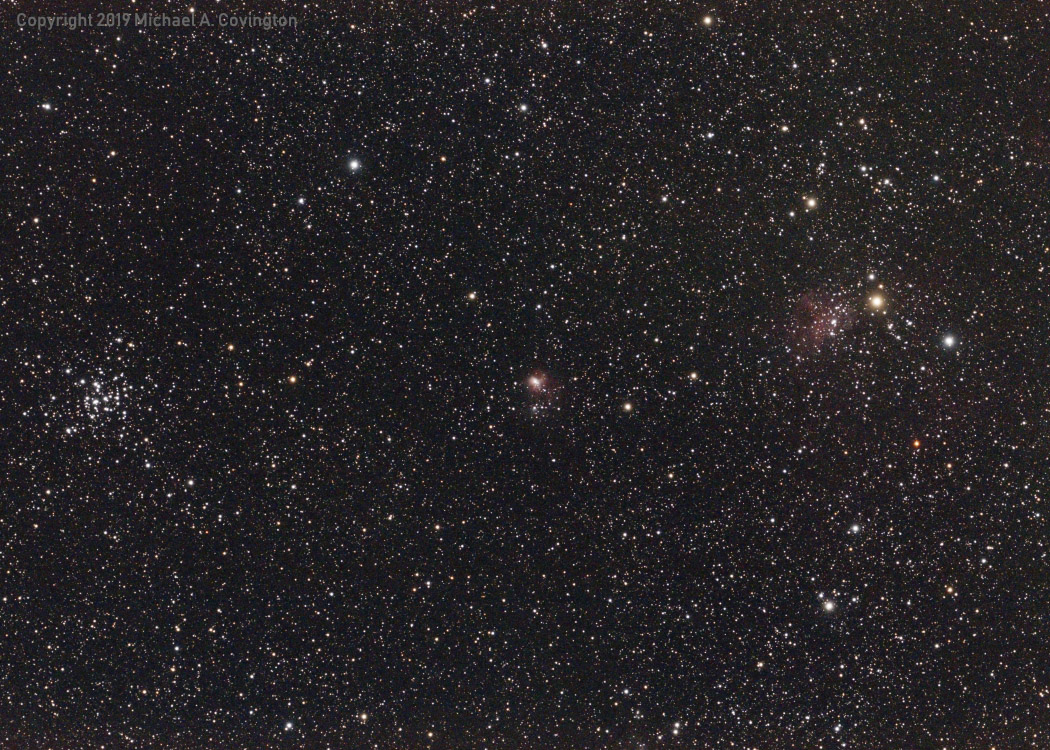
Stack of twenty 1-minute exposures.
Permanent link to this entry
Nebulae in Gemini
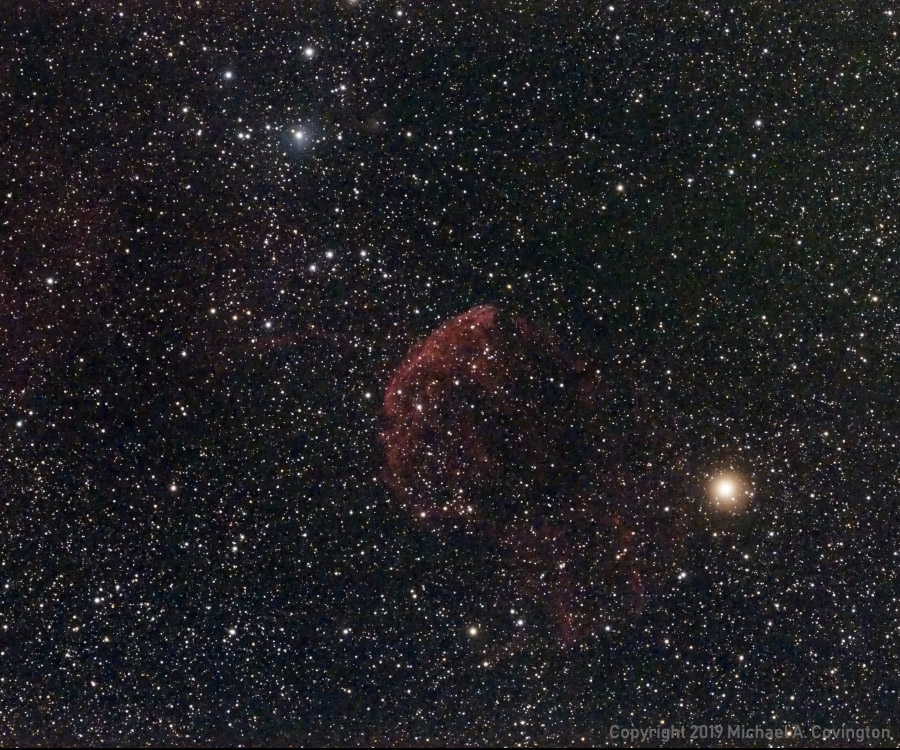
The red object here is IC 443, the Jellyfish Nebula (it would look more like a jellyfish
if you could see more of it), a supernova remnant in the same part of the sky as
Eta Geminorum (at lower right) but not close to it physically or related to it.
You can also see some reflection nebulosity around the star 12 Geminorum, near the top.
This time my mount didn't track quite as well, and I used only 12 of the 20 exposures
that I took. Otherwise same as the pictures above.
Permanent link to this entry
Comet Wirtanen retreats
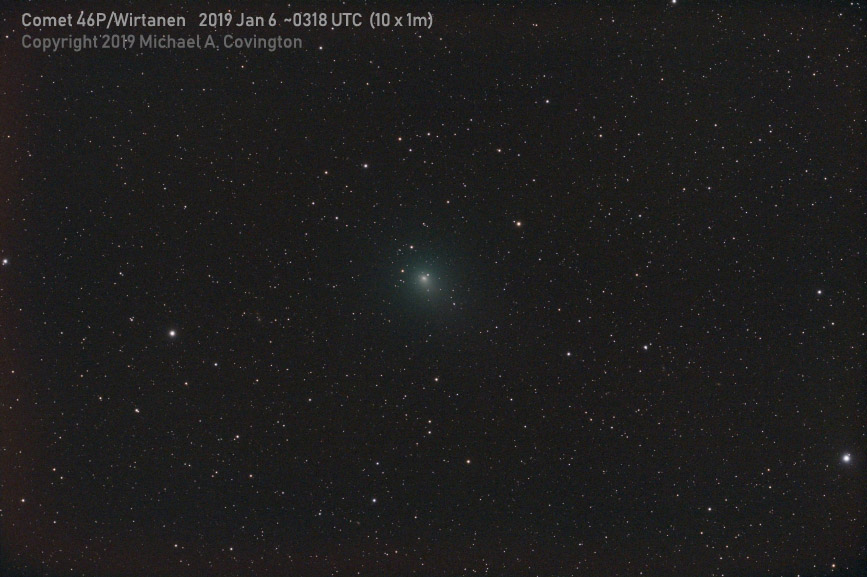
The comet is farther away now, but, paradoxically, this may be my best picture of it,
because now, it's moving across the sky slowly enough that I was able to stack ten 1-minute
exposures (with half-minute gaps between them, spanning a total of 15 minutes).
The comet is slightly smeared in a horizontal direction, but only slightly.
The tail, such as it is, extends down and to the right.
Same equipment and technique as the pictures above.
Permanent link to this entry
Artificial rudeness
The telephone just rang, and it was the rudest robocall I've ever received.
It sounded like a human being, perhaps one playing segments of a recorded pitch
by pressing buttons. If no human was listening, I have no idea why they kept
asking me questions. But there the madness only began.
The voice was a simulation of a chatty middle-aged woman. "Michael? This is (name)
at Women's Cancer Fund. I was just
calling to let you know we are mailing..."
But every time I opened my mouth (trying, of course, to interrupt and ask questions),
they skipped to a different part of the chatty spiel. "Oh, I know it may not be the
best of times, but we just..."
It was like a conversation with a rude person who was also insane.
Please, everyone, if you want to play a recorded pitch, do it honestly, and conceivably
I might listen. If you use a computer to both deceive and be rude to me,
I'll never trust anything you say.
I have no idea whether Women's Cancer Fund is a legitimate charity, and, if so,
whether this was really them.
I was very careful never to say "Yes." I've heard of people recording a victim's voice
saying "yes" and using it to fake a recording of them agreeing to buy something.
Permanent link to this entry


|
2019
January
9
|
Shutting down the government is wrong
Shutting down the government (by refusing to fund it) is not a legitimate
tactic of political negotiation.
It is wrong for the same reason taking hostages is wrong: it harms people
against whom neither side has any grievance.
And we are in the middle of a shutdown now.
Shutdowns basically result from deadlocks within Congress; in this case, between
the House of Representatives (Democrats) and the Senate (Republicans) over whether
to build a "border wall" (variously defined).
The Senate won't pass legislation to keep funding the government unless it includes
something the House doesn't want to include.
Meanwhile, parts of the government are shut down, payments are not being made,
employees are either furloughed or commanded to work without pay, and at last report,
the water bill for the White House hasn't been paid (hmmm...).
Unlike past shutdowns, which have lasted a few days,
this one is vigorously advocated by the President, who threatens
to keep it going for months.
Why does anyone think this is the right thing to do?
Does it fulfil the government's moral duty to its employees and contractors? No.
That's why other businesses never try it.
The nearest they come is that sometimes they have lockouts when their dispute is
actually with the workers they are locking out.
Does it convince other potential employees and suppliers that the government is good to
work for, and that they should seek jobs there or give it good deals? No. There are hidden costs associated
with being an unreliable payer. This is Econ 101, not some controversial theory.
Does it convince the rest of the world that the American system of government is best?
No. It makes us look like an unstable temporary regime
that doesn't mind stomping on its own citizens.
Shutting down the government over a political dispute is just like taking hostages.
"Because I can't get my way on the border wall, people I've never seen, against whom I have no
grievance, are going to go without pay." That is not how a morally responsible person thinks or acts.
I would favor constitutional changes to make shutdowns much harder. It's probably not
feasible to make them impossible, but we might say that all federal elected officials
forfeit their salaries for 3 times the length of every shutdown, and all their benefits
(such as health insurance) for the duration of the shutdown, and that the president cannot veto
legislation that would end a shutdown. Those are just ideas; maybe we can come up with something
better.
Permanent link to this entry
Flu!
Within hours of getting Melody home on Saturday (Jan. 5), I came down with the flu.
I should have known something was wrong when, during that evening's astronomy session,
the temperature was 50 F but I felt as if I were in the Arctic.
By midnight I was quite sick, and in spite of being vaccinated, I've had a 4-day bout with the flu,
probably to be followed by several days of being mildly sick. But it's not as bad as the flu
of 1978 or quite a few others. Maybe the vaccine attenuated it a little.
Permanent link to this entry


|
2019
January
5
|
Melody and rhythm — the saga continues
Melody actually stayed in the hospital until today (January 5) for adjustment of medications to
control heart rhythm. I spent much of my time sitting with her, often doing computer work.
She's home now, with a steady heartbeat, and I'll write more Notebook entries later.
Three very short notes:
(1) Stellarium is a great piece of software, but version 0.18.3
has two bugs that impact astrophotographers. (1) For me, and for some users but not all, its field-of-view plug-in
fails to display whether a Barlow lens is chosen. (2) The Windows installer, by default, has "Remove plug-ins' settings"
checked, which will wipe out your file of telescopes, eyepieces, and cameras unless you uncheck it.
Windows users can simply download 0.18.2 and install over 0.18.3. Linux users can go into Synaptic Package Manager,
remove "stellarium" and "stellarium-data", and then choose Package, Force Version, and choose version 0.18.0 for those
packages. Install them and "lock version" (to prevent updates) and you're done. Interestingly, your settings
(in "~/.stellarium") survive this whole process.
Then, if you do your updates with apt, as I do, what you should do is look in the
directory /etc/apt/sources.list.d, find the Stellarium file, and delete it or move it
elsewhere. Then sudo apt update and sudo apt upgrade will leave Stellarium alone.
When all this blows over, you can restore the Stellarium file or regenerate it with
the command:
sudo add-apt-repository ppa:stellarium/stellarium-releases
UPDATE: The bugs are fixed in the latest beta version, 0.18.3.16493.
Click here to get it.
(2) This government shutdown is nothing but a display of incompetence.
Instead of debating what we need to build at the border, and reaching a working compromise, Congress and the President
have turned it into a simple power struggle — either give Trump exactly what he wants, because he wants it,
or be deadlocked. This is harming large numbers of innocent people against whom no one has any grievance, exactly
as if they were hostages in a standoff. And it is convincing the rest of the world that the American government
and the American way are not to be trusted. Cui bono?
(3) I implore you not to "pass along" or "copy and paste" anything on Facebook that you do not fully
understand and endorse. You're putting it on the Internet with your own name on it, even if it's a soliciation
from credit card thieves or scammers of some other kind.
I am dismayed at the number of people who will copy and paste "I tried this and it really worked" or "An attorney told
us to do this" when they didn't try it and there was no attorney. Do they realize what this tells us about their
personal honesty? Or ability to read?
Permanent link to this entry


|
|
|
This is a private web page,
not hosted or sponsored by the University of Georgia.
Copyright 2019 Michael A. Covington.
Caching by search engines is permitted.
To go to the latest entry every day, bookmark
http://www.covingtoninnovations.com/michael/blog/Default.asp
and if you get the previous month, tell your browser to refresh.
Portrait at top of page by Sharon Covington.
This web site has never collected personal information
and is not affected by GDPR.
Some older pages that contain Google Ads may use cookies to manage the rotation of ads.
No personal information is collected or stored by Covington Innovations, and never has been.
This web site is based and served entirely in the United States.
In compliance with U.S. FTC guidelines,
I am glad to point out that unless explicitly
indicated, I do not receive substantial payments, free merchandise, or other remuneration
for reviewing or mentioning products on this web site.
Any remuneration valued at more than about $10 will always be mentioned here,
and in any case my writing about products and dealers is always truthful.
Reviewed
products are usually things I purchased for my own use, or occasionally items
lent to me briefly by manufacturers and described as such.
I am an Amazon Associate, and almost all of my links to Amazon.com pay me a commission
if you make a purchase. This of course does not determine which items I recommend, since
I can get a commission on anything they sell.
|
|



















